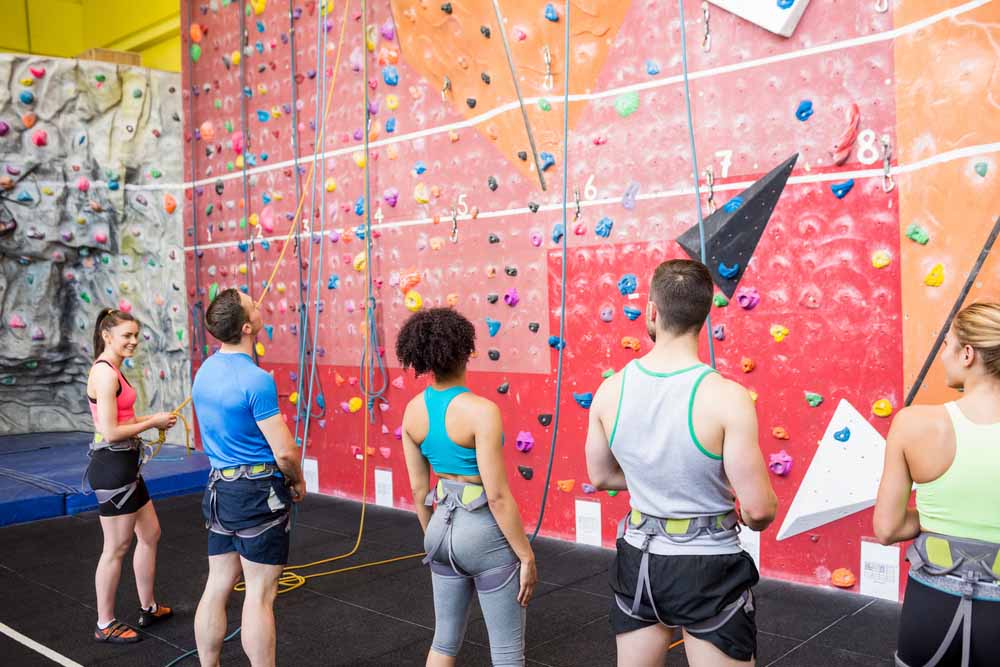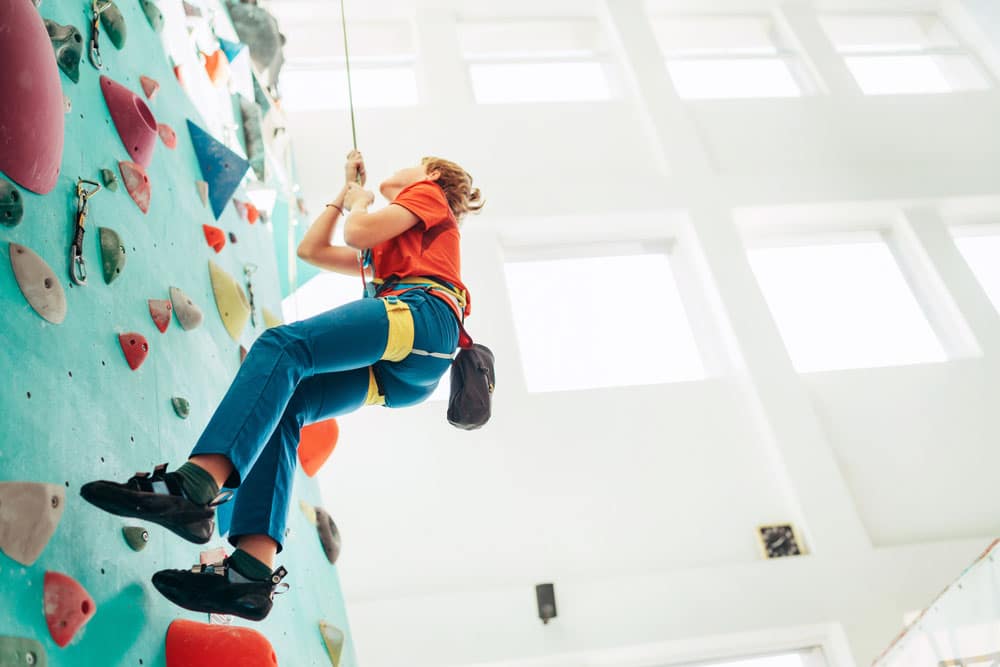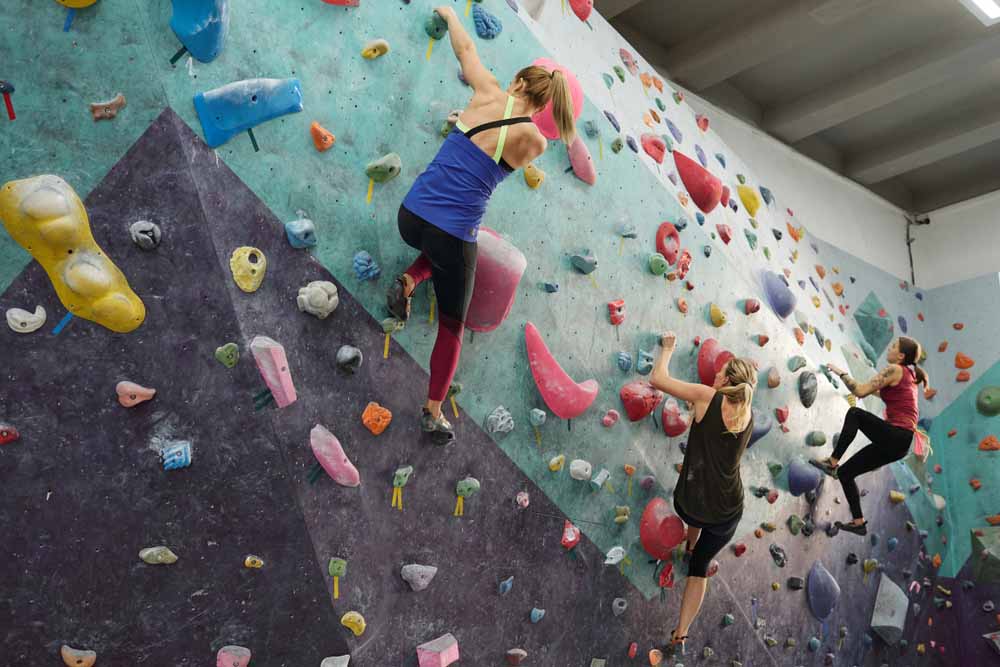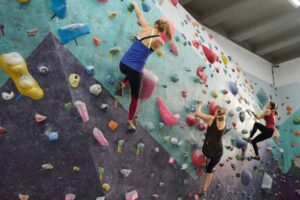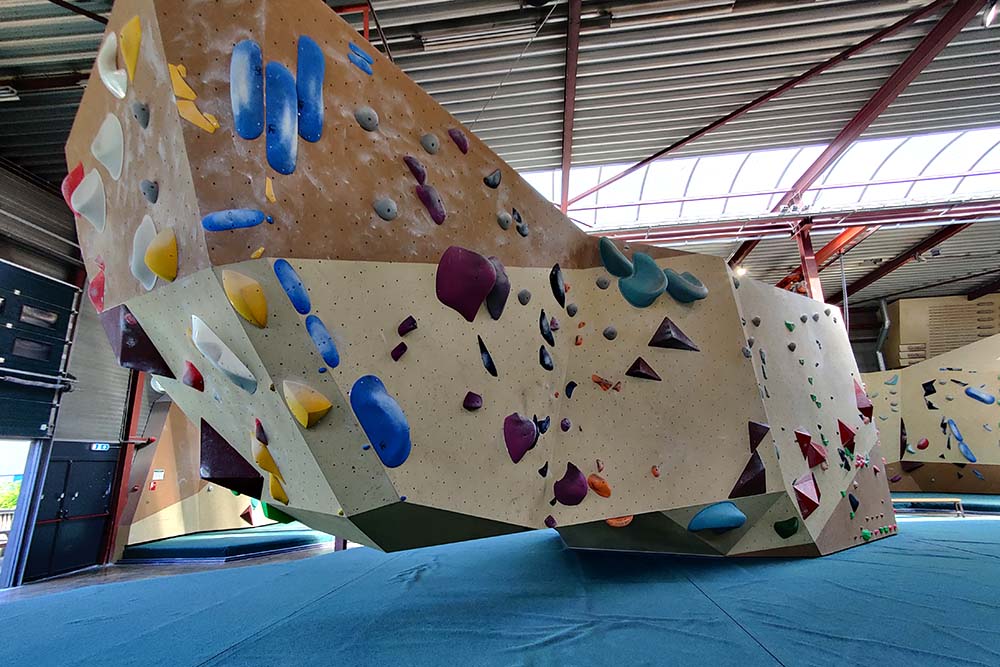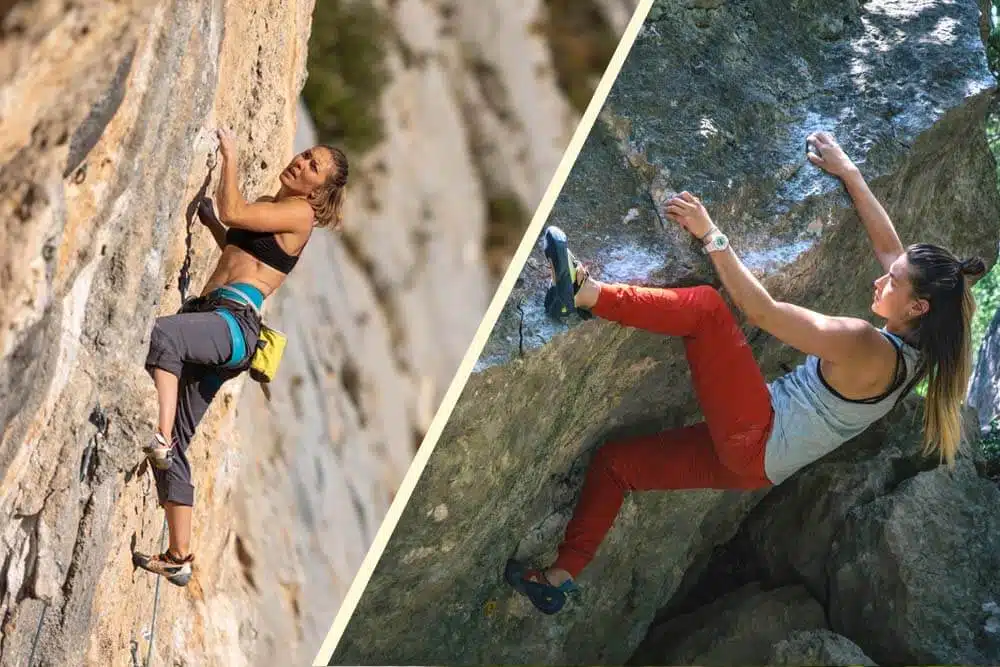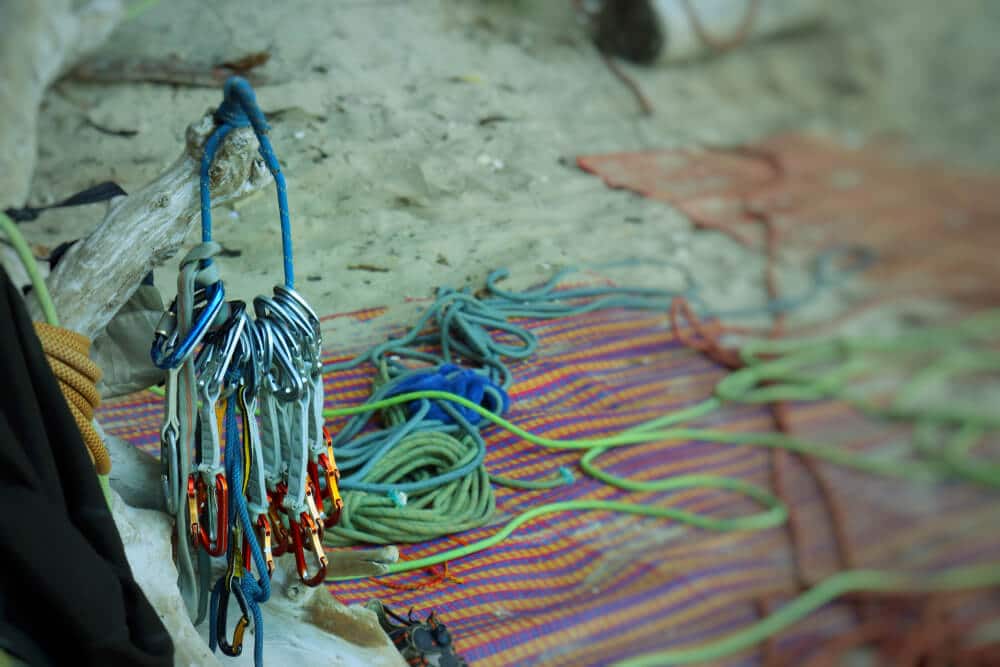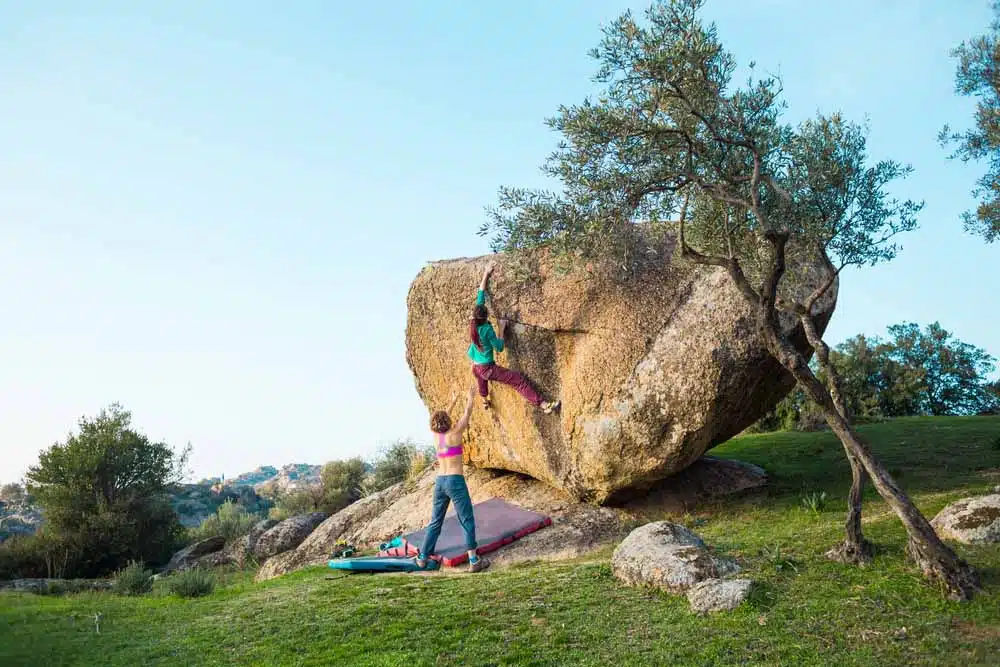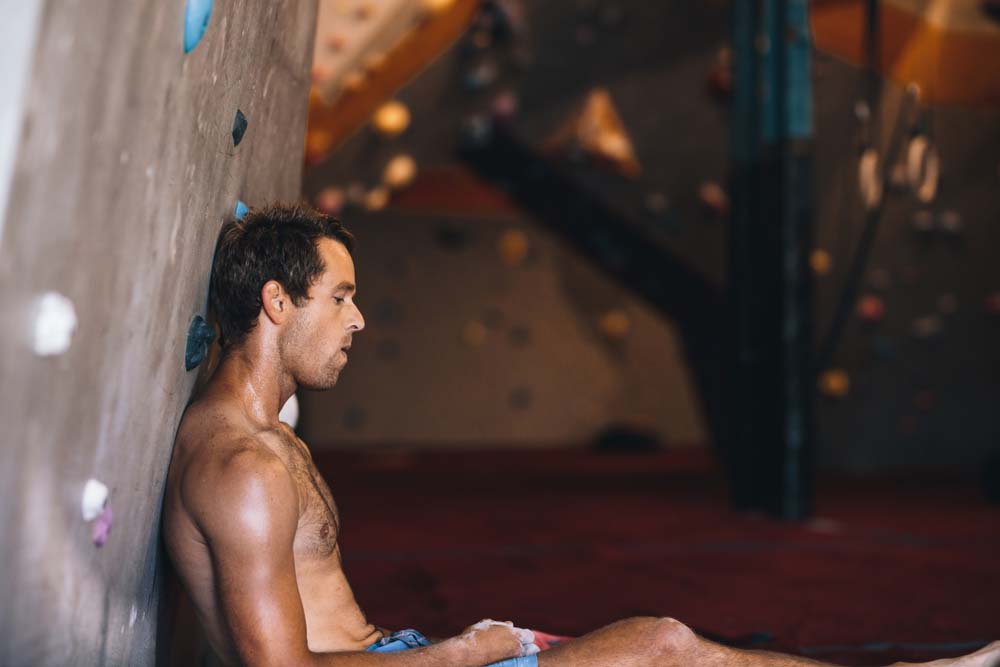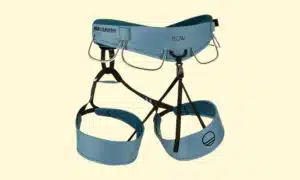Rock climbing is often intimidating for beginners. At first glance, the sport may appear risky, difficult, and technical, requiring both a very specific type of fitness and a deep level of knowledge.
Think about it this way. If you found a random person on the street and showed them a video of someone playing soccer, and then a different video of someone climbing (even on an easy route), chances are they’ll feel far more comfortable picking up the basketball than the climbing rope.
That doesn’t mean climbing is a difficult sport for beginners. Most of the intimidation people feel about climbing is misplaced.
In fact, climbing has a very fast learning curve, particularly with the advent of modern indoor climbing gyms and advanced technology like autobelays and assisted braking belay devices (GriGris, for example).
If you’re physically fit enough to climb a ladder, then there are climbing routes out there that you can complete! If you can follow basic rules and learn one or two knots, then basic rope climbing will be safe and accessible for you, too!
We’ve already written guides about how to get started climbing, but if you want to learn a bit more about the sport before you buy some gear, sign up for a gym membership or training course, and start roping up, then this article will help you.
Let’s learn about how difficult the climbing journey is for a beginner, and try to dismantle some of the preconceived notions people have about what rock climbing requires.
What is Intimidating About Rock Climbing?
Most beginners look at climbing and are discouraged by two factors. Let’s break ’em down.
Physical Difficulty
Climbing can appear extremely physically demanding, and many feel that they are not physically fit enough to participate in the sport. This is a fallacy. There are climbing routes of all difficulties, fit for just about anyone. if you can scramble up a steep staircase, then there are climbing routes out there that you can complete.
Technical Knowledge
The other factor that intimidates people about climbing is the technical aspect. Climbing is a safe sport, but only if practitioners learn and follow safety procedures, and use proper equipment, like harnesses, ropes, and carabiners. Sometimes these skills and equipment can seem complex and daunting.
The good news for modern climbers is that there are several ways to make learning easier. Let’s learn more!
Indoor Climbing Gyms: Your School and Training Ground for Climbing
Modern climbing gyms offer a wealth of resources for beginners. These include established bouldering walls with permanent pads beneath them, rental gear and equipment for members to use while on gym premises, auto belays to climb roped routes without a partner, and instructional courses for new climbers to learn the basics of rope climbing, like how to tie in, how to belay, and how to lead climb.
The resources at your local climbing gym may vary, but it’s certainly the best place for you to begin a climbing journey, and it will make sure you progress in a safe, controlled manner as you grow in climbing skill, fitness, and experience.
Let’s discuss a few things your climbing gym can offer.
Auto Belays
Auto belays are fixed belay systems that automatically belay you while climbing an indoor route.
Auto belaying allows you to tackle long rope routes without a partner (or the technical knowledge to tie in and belay, even if you do have a partner). All you have to do to safely use an auto belay is clip the auto belay’s carabiner into your harness belay loop, check that the carabiner is locked, and begin climbing.
NOTE: Ensure you stay on route, and climb directly below the auto belay, as injury can result from climbing too far to one side or the other, causing a “swing” if you fall.
Auto belays are great tools for new climbers to get experienced with the heights and stamina required to climb longer rope routes.
Bouldering Walls
Bouldering is an excellent way to practice the movement, technique, and strength required for climbing without any technical knowledge whatsoever. Like auto belays, you also don’t need a partner.
Most indoor rock climbing gyms have permanent padding below the walls to protect in the event of a fall, so you don’t need to bring your own pad. Because most gyms also rent climbing shoes, you can quite literally show up and climb without a single piece of gear.
If you’re looking to build the stamina and endurance required for roped climbing, try traversing the walls just a foot or two off the ground and seeing how far you can make it without falling.
NOTE: Avoid doing this if there are other climbers on routes or problems in your way. This is a training technique best used if the gym is near-empty.
Education Opportunities
Climbing gyms are also an excellent resource for new climbers, offering classes that can teach you how to belay, how to tie in, and how to build anchors, among other important climbing techniques and skills.
When you utilize the educational opportunities at your climbing gym, climbing becomes significantly less intimidating.
Climbing Outside: Rope Climbing vs. Bouldering, Which is Best for Beginners?
Outdoor climbing encompasses many disciplines, including sport climbing, traditional climbing, alpine climbing, and bouldering, but not all of these require gear and technical knowledge. One of these is bouldering, and if you’re interested in climbing outdoors as a beginner, it’s the best way to start.
Little Gear
Bouldering requires only a pad and a pair of climbing shoes, as well as some chalk for grip, if you prefer. You can boulder anywhere in the world without the use of a rope, harness, helmet, or any other complex technical gear. That makes it an extremely easy discipline for newer climbers.
Low Cost
As a result of the lack of gear required, the start-up costs to begin your climbing journey as a boulderer are quite low. With only $200 to $300, you can secure a pad, chalk bag, and a decent pair of climbing shoes. That’s all you need!
Minimal Technical Knowledge
Because you aren’t using any gear, you also don’t need any technical knowledge to stay safe while bouldering. It’s certainly a discipline with plenty of room for injury, but the skills you need to learn to boulder safely are more intuitive than technical. There are no knots, anchor systems, or other complicated principles at play.
If you learn how to fall properly, place pads, and spot a problem, you’ll be a safe boulderer! Besides, most of this knowledge is fairly obvious, and you and your partners can learn as you progress.
No Partner?
It’s always best to climb with someone else, but bouldering is one of the few climbing disciplines where you don’t strictly need a partner, even as a beginner. Depending on the problem you’re climbing, it is relatively safe to go bouldering outdoors by yourself.
The Best Discipline for New Climbers Outside… Bouldering!
As a result, bouldering is the best discipline for newer climbers who are looking to climb outside.
If you have easy access to an indoor rock climbing gym (mentioned above), then roped climbing may also be viable for you, because you can first receive instruction in basic top rope principles from gym staff, train on an auto belay, and fixed top rope anchors, and overall practice in a safe, monitored environment before heading outdoors.
Rock Climbing Fitness: How Hard is Climbing?
Climbing is a physically demanding sport, there’s no question about it. Strength, endurance, balance, and flexibility will all contribute to your climbing prowess.
You don’t simply have to be strong or flexible in one region of your body though, but holistically, throughout your body, from your forearms to your core to your back and legs.
Compared to other sports, however, climbing is particularly dependent on strength in the fingers and forearms. That said, there are disciplines that rely more heavily on other parts of the body, such as slab (low-angle) climbing, which requires primarily balance and footwork and little-to-no upper body strength.
Another key aspect of your climbing fitness is your strength-to-weight ratio. Because you’re constantly pulling yourself upward as a climber, the best climbers are those with a high level of strength in relation to their body weight, not necessarily a high level of overall strength.
As a result, an extremely high bench press, deadlift, or squat max, for example, isn’t going to correlate to a high climbing level. The ability to perform high reps of body weight exercises like pull-ups, dips, and pushups is more indicative of a high level of climbing fitness.
Cardiovascular fitness is also important, particularly for the speed climbing discipline, but also for long rope routes. As mentioned above, the same is true of flexibility and balance.
Sports that Help with Climbing
Activities like running, swimming, cycling, gymnastics, and yoga translate to rock climbing quite well. If you have a background in any of these activities, you’re likely to excel as a rock climber.
Conclusion: Rock Climbing Is NOT Hard for Beginners
Rock climbing is an intuitive sport, something we’ve all likely been practicing since childhood without even knowing it! If you’ve ever climbed a tree, a ladder, or the side of a couch as a child, then you’ve experienced some of what we do as climbers.
Remember, climbing is a vast and diverse sport, and it can be as hard or as easy as you want it to be. From the frozen ramparts of high-altitude climbs in the Karakorum to 10-foot plastic boulder walls at your local climbing gym… you can truly choose your own adventure while climbing.
So don’t be intimidated. Get out there!


